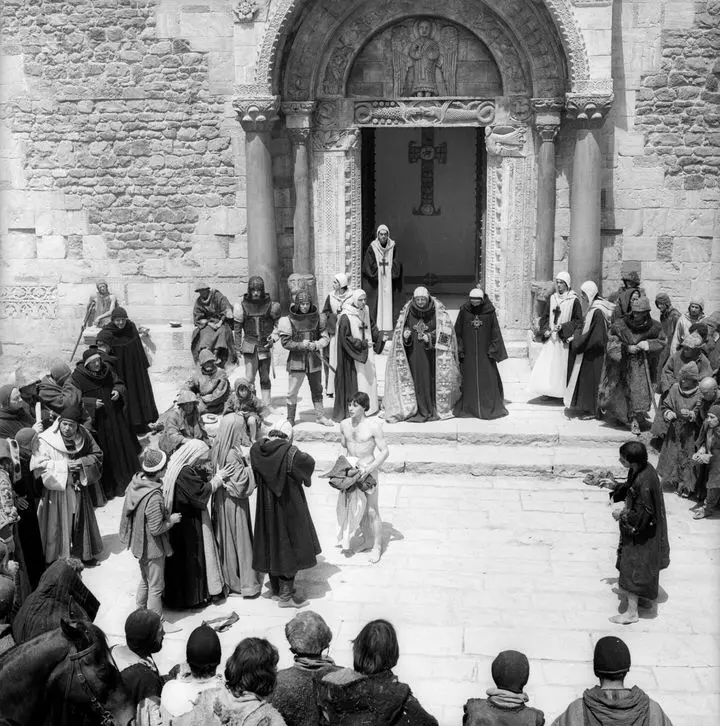

Assisi, Francis’ birthplace, was recreated in various places in Umbria and Tuscany, including the Fortezza di Montalcino (SI) in Val d’Orcia, which features a papier mâché façade of a church. This features in the early scenes when Francis shows off his armour to friends, and also as the location for the memorable scene where he divests himself of all his riches to leave in poverty and communion with nature. The church interiors, seen during the mass held before they depart for war and when Francis is attracted by the light that will gradually convince him to leave his riches for a life of poverty, are those of the Abbey of Sant’Antimo in Castelnuovo dell'Abate, Montalcino. The towers of San Gimignano (SI) welcome Francis on his return from the war. Other areas featured include the alleyways and Palazzo dei Consoli of Gubbio (PG).
The Marmore Waterfall (TR) is the background for a scene where Francis watches Clare feed and treat lepers; in the same place, the boy, now converted, welcomes Clare into his new life, with the symbolic gesture of cutting her hair off.
Francis and several disciples rebuild the ruined church where they settle: this is in Pian Grande, Castelluccio (PG), part of the timeless setting of Parco Nazionale dei Monti Sibillini. The church of St. Damian, here built in papier mâché, is actually in Assisi.
The last scene, where Francis accepts the authority of the Pope and the Pope accepts the authority of the future saint by approving his Rule was shot in the Cathedral of Santa Maria Nuova in Monreale (PA).
Assisi, Francis’ birthplace, was recreated in various places in Umbria and Tuscany, including the Fortezza di Montalcino (SI) in Val d’Orcia, which features a papier mâché façade of a church. This features in the early scenes when Francis shows off his armour to friends, and also as the location for the memorable scene where he divests himself of all his riches to leave in poverty and communion with nature. The church interiors, seen during the mass held before they depart for war and when Francis is attracted by the light that will gradually convince him to leave his riches for a life of poverty, are those of the Abbey of Sant’Antimo in Castelnuovo dell'Abate, Montalcino. The towers of San Gimignano (SI) welcome Francis on his return from the war. Other areas featured include the alleyways and Palazzo dei Consoli of Gubbio (PG).
The Marmore Waterfall (TR) is the background for a scene where Francis watches Clare feed and treat lepers; in the same place, the boy, now converted, welcomes Clare into his new life, with the symbolic gesture of cutting her hair off.
Francis and several disciples rebuild the ruined church where they settle: this is in Pian Grande, Castelluccio (PG), part of the timeless setting of Parco Nazionale dei Monti Sibillini. The church of St. Damian, here built in papier mâché, is actually in Assisi.
The last scene, where Francis accepts the authority of the Pope and the Pope accepts the authority of the future saint by approving his Rule was shot in the Cathedral of Santa Maria Nuova in Monreale (PA).

Euro International Films, Vic Film
The life of St. Francis of Assisi, from the events that led to his conversion to his meeting with the Pope.